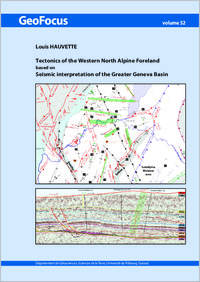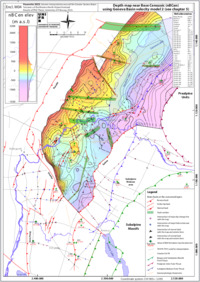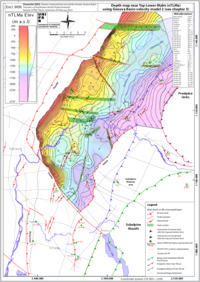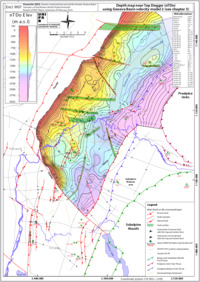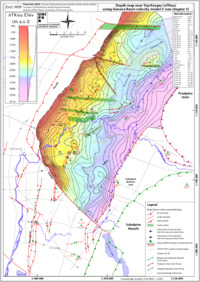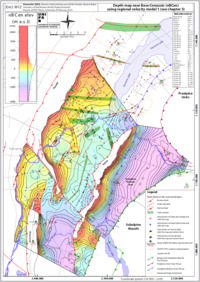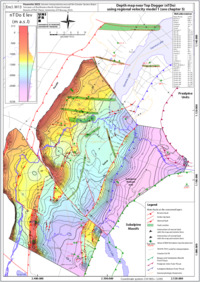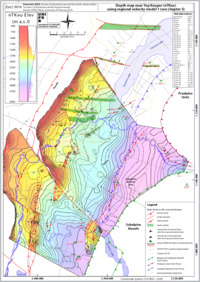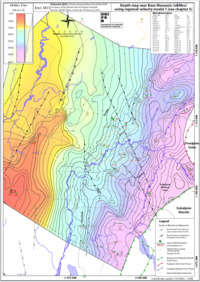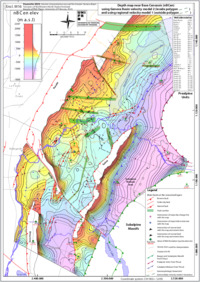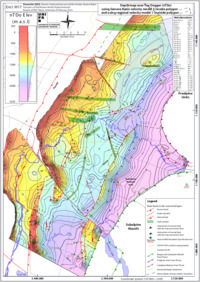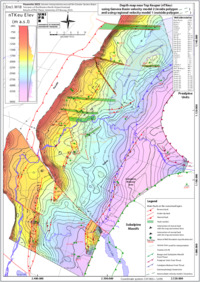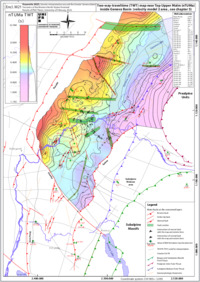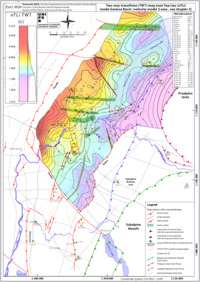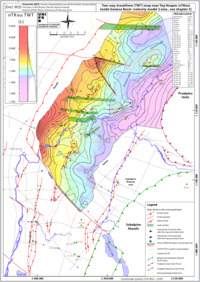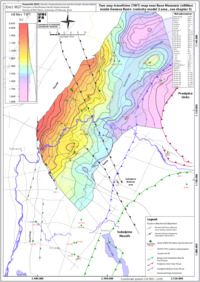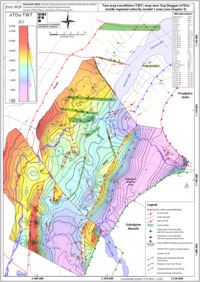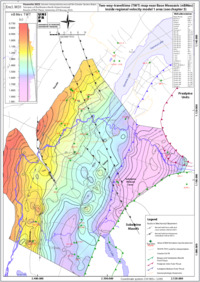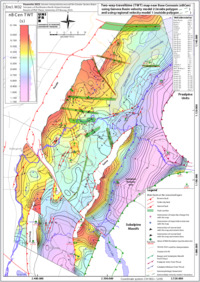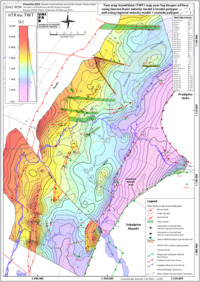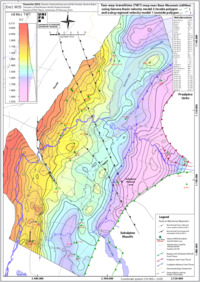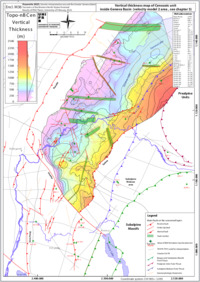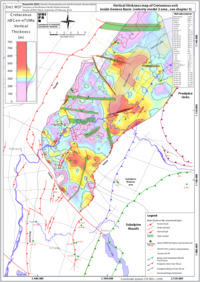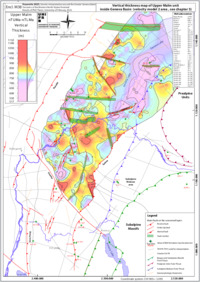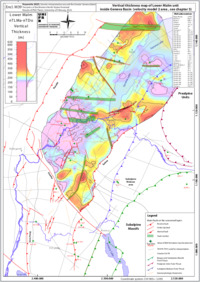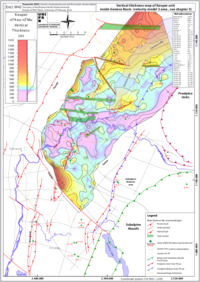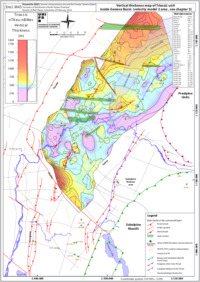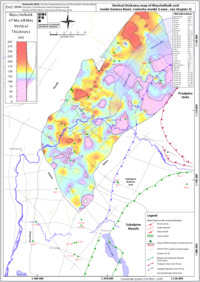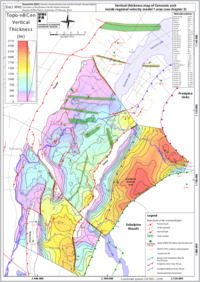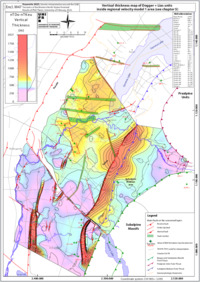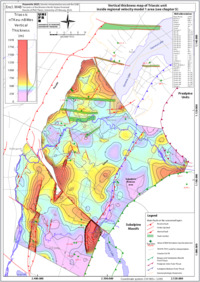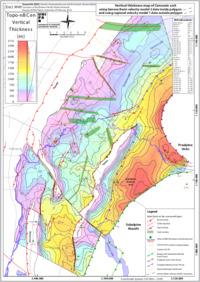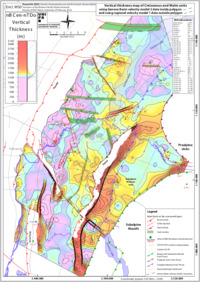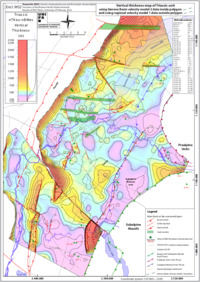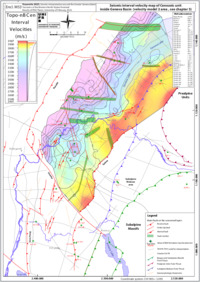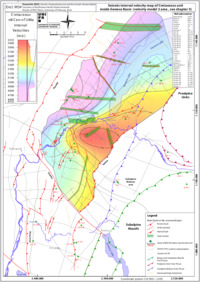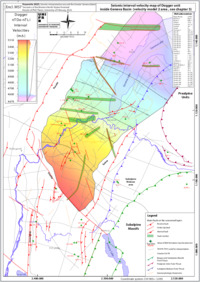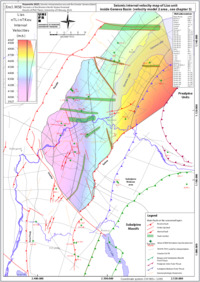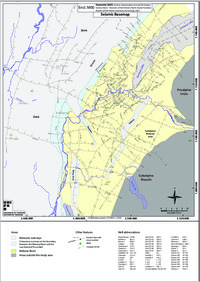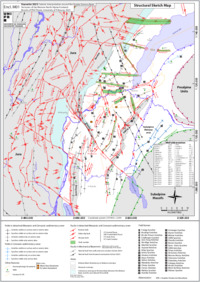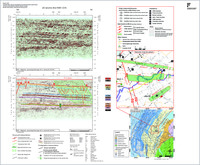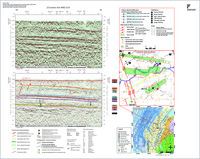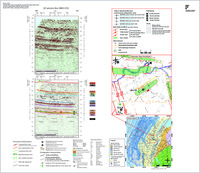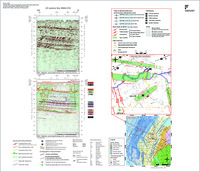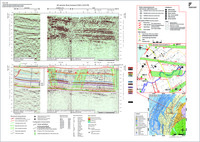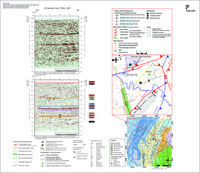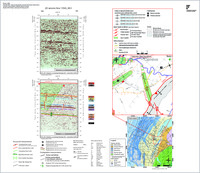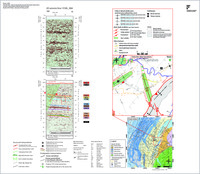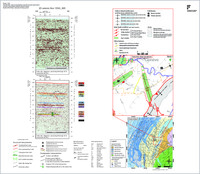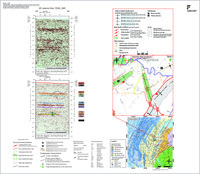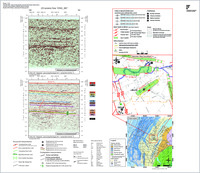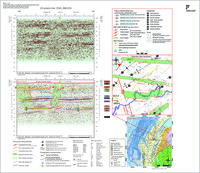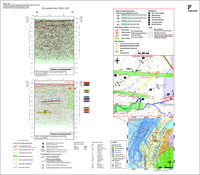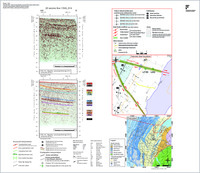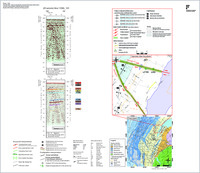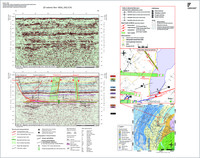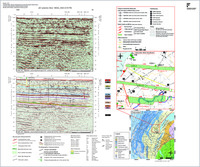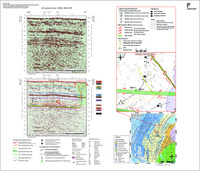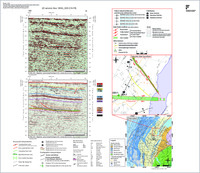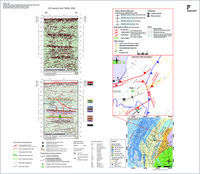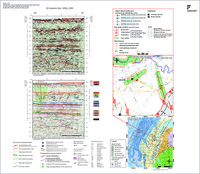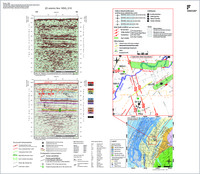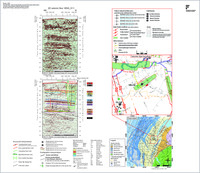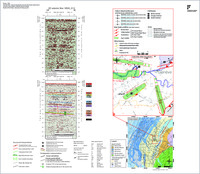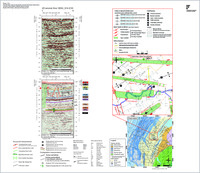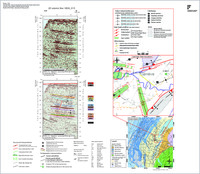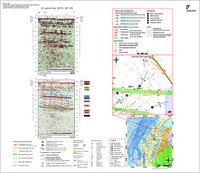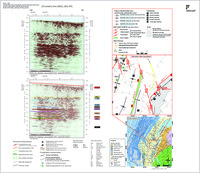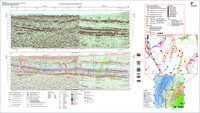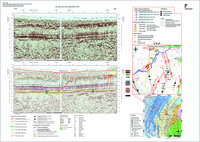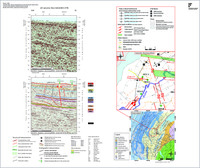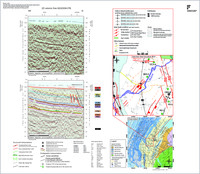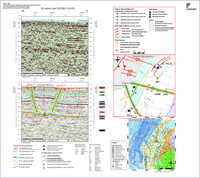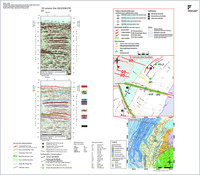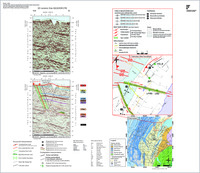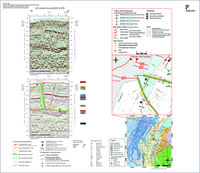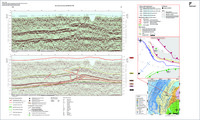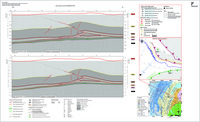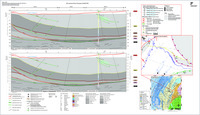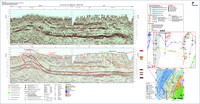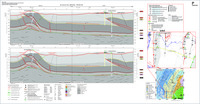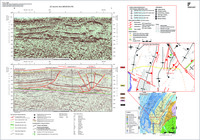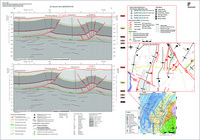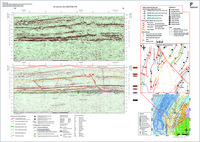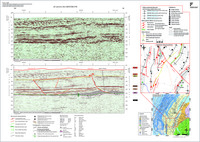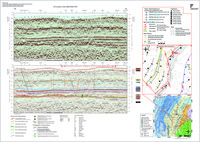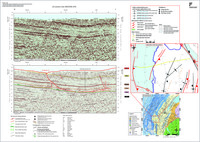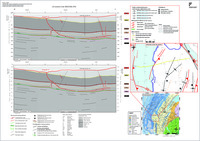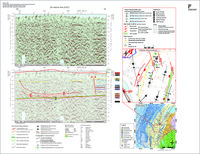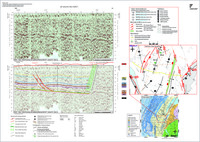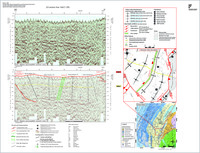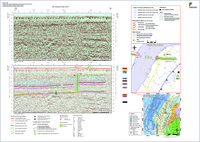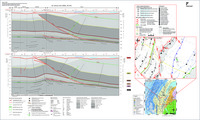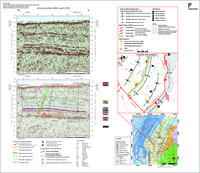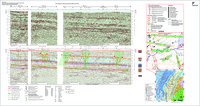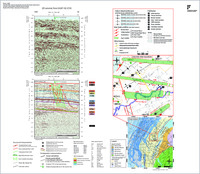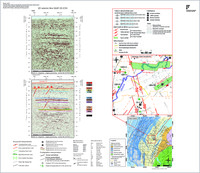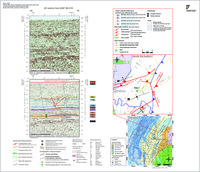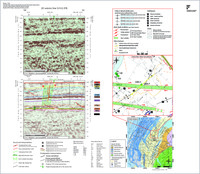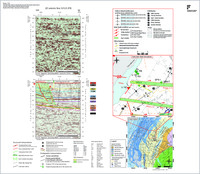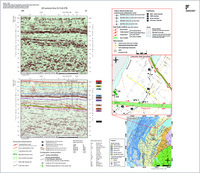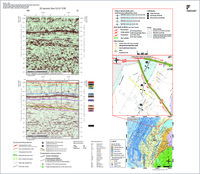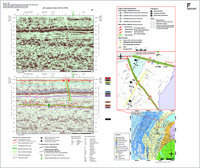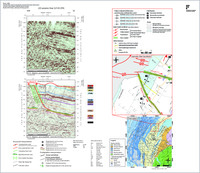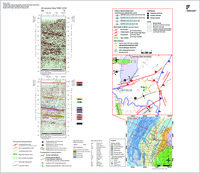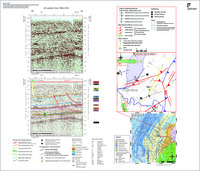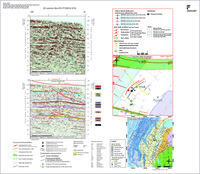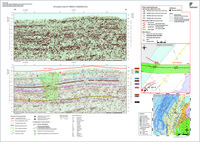Tectonics of the Western North Alpine Foreland based on seismic interpretation of the Greater Geneva Basin
DOKPE
- Hauvette, Louis University of Fribourg
- Fribourg (Switzerland) : Département de géosciences, sciences de la Terre, March 2024
1 ressource en ligne (270 pages) ; 1 fichier pdf
Thèse: Université de Fribourg (Suisse), 2024
Published in:
- Geofocus. - 2024, vol. 52
English
The North Alpine Foreland (NAF) is divided into two domains: the Molasse Basin (MB) and the Jura fold-and-thrust belt (FTB). These domains are detached from the mechanical basement above a décollement in the Triassic evaporites. Thrusts, folds and strike-slip faults are the major structures developing in the detached Mesozoic and Cenozoic sedimentary cover of the area. These structures are mainly related to the Cenozoic Alpine orogeny and part of them are inherited from the Jurassic extensional period (reactivation). Pre-existing faults in the basement may also influence the development of these structures in the frame of the thin-skinned or thick-skinned deformations. The Geneva Basin, in western Switzerland, is part of the Plateau Molasse within the Molasse Basin and is limited to the NW by the JJFTB and to the SE by the Subalpine Molasse (SAM). The “GEothermies” project of the Canton Geneva has provided an incentive to re-assess the structural setting and kinematics of the westernmost portion of the North Alpine Foreland, including the Haute Chaine domains of the Jura Fold-and-Thrust Belt. Therefore, the analysis extends from the Geneva Basin to the neighboring regions of the Salève to the Southeast, the Vuache fault system and the Rumilly Basin to the South, as well as the Jura Mountains to the West. The seismic interpretation is based on vintage surveys since 1960’ and recently acquired 2D seismic data in 2018 (more than 150 seismic 2D profiles). It was combined with surface data e.g. bedding dips, geological maps, DEM, and especially with 66 wells (in the database) and various georeferenced maps from the literature. This study relied on this comprehensive dataset to create the following new geological and geophysical outputs:
- A new regional refined positioning of the near pre-Mesozoic basement surface (nBMes), for all the neighboring area of the Geneva Basin. It includes the Rumilly Basin, the Subalpine Molasse area and more importantly a part of the Internal Jura. This was achieved using a new sophisticated regional velocity modelling and depth conversion methodology using the four regionally interpreted seismic horizons, near Base Cenozoic (nBCen), near Top Dogger (nTDo), near Top Keuper (nTKeu), near Base Mesozoic (nBMes).
- A new refined and high-resolution depth model of the Geneva Basin. We specifically focused on this area, since it is the main interest of the “GEothermies” project run by SIG in the Canton of Geneva. It is based on the following eight interpreted seismic horizons; near Base Cenozoic (nBCen), near Top Upper Malm (nTUMa), near Top Lower Malm (nTLMa), near Top Dogger (nTDo), near Top Lias (nTLi), near Top Keuper (nTKeu), near Top Muschelkalk (nTMu), near Base Mesozoic (nBMes). Subsequently we implemented a more refined and advanced timeto- depth conversion method in comparison to the regional velocity model. It consists of a complex polynomial velocity law for the Cenozoic layer and of advanced interpolated interval velocity grids for the other Mesozoic layers.
- A seismic line catalogue (PDF files, see Enclosures) showing the raw data, the interpretation and the geological model. In addition, some 20 lines are also presented in depth converted format.
- A new kinematic model together with a new structural model shown in the new tectonic map of the area. Then, the structures identified were analyzed in relation with the main thickness (thickness maps) and seismic facies lateral variations. Indeed, the depositional seismic signature of each sub-unit has also been investigated and compiled in a seismic facies catalog.
The main structural and geological findings of our seismic interpretation concerns the following specific fault zones or seismic facies distribution:
- We have identified fault corridors that act as conjugate strike-slip fault systems that are an extension of the fault systems known from the Jura FTB and which thus extend into the Molasse Basin. These corridors measure in the Geneva Molasse Basin, up to 15km length and around 500 m wide, and are made of multiple non-correlated near vertical small-scale fault segments of vertical extent around 100-300ms.
- Two main different conjugate strike-slip fault settings can be identified east and west of the Vuache Fault Zone:
o East of the Vuache FZ, we observe E-W striking dextral strike-slip faults (e.g Saint-Cergue FC, Divonne FC, Prévessin FC, Meyrin FC, or Aire-la-Ville FC) conjugated with NNW-SSE sinistral strike-slip faults (e.g Le Coin FC, or Mourex FC). This conjugate setting corresponds to a NW-SE oriented shortening direction.
o West of the Vuache FZ, ENE-WSW oriented dextral strike-slip faults conjugated with NW-SE sinistral strike-slip faults, suggesting a WNW-ESE shortening direction.
- Syn-sedimentary extensional listric normal faults have been clearly identified and interpreted, with a main activity and growth during the Early to Middle Jurassic period (especially during the Lias). These faults have been subsequently modestly inverted during alpine compression. They form an extensional imbricated fan zone developed along, and east of the leading NW-SE strike-slip Vuache fault zone. It encompasses the NE-SW striking SEvergent Humilly FZ linked as a branch to the Vuache leading fault. These inherited fault system, may also include the Salève FZ belt that was interpreted with the same extensional Jurassic syn-sedimentary activity. The NE-SW Pougny FZ and the Cercier FC are attached to the same extensional system but possibly dated from the Eo-Oligocene extensional period. Other NESW fault branches may also be associated to the Vuache-Humilly-Salève FZ. This concerns fault zones west of the Vuache FZ such as the Musiège FZ or the Gros Foug FBT.
- Seismic facies trends have also been investigated especially in relation to the Eocene (Siderolithic) and Upper Malm facies (recifal complex). The sedimentary origins were analyzed in relation to the structural configuration at the depositional time (important role of the paleo-topographical highs).
This study has made it possible to better constrain the alpine and synsedimentary structural setting of the western Alpine foreland surrounding Geneva and develop a new tectonic and kinematic understanding.
- A new regional refined positioning of the near pre-Mesozoic basement surface (nBMes), for all the neighboring area of the Geneva Basin. It includes the Rumilly Basin, the Subalpine Molasse area and more importantly a part of the Internal Jura. This was achieved using a new sophisticated regional velocity modelling and depth conversion methodology using the four regionally interpreted seismic horizons, near Base Cenozoic (nBCen), near Top Dogger (nTDo), near Top Keuper (nTKeu), near Base Mesozoic (nBMes).
- A new refined and high-resolution depth model of the Geneva Basin. We specifically focused on this area, since it is the main interest of the “GEothermies” project run by SIG in the Canton of Geneva. It is based on the following eight interpreted seismic horizons; near Base Cenozoic (nBCen), near Top Upper Malm (nTUMa), near Top Lower Malm (nTLMa), near Top Dogger (nTDo), near Top Lias (nTLi), near Top Keuper (nTKeu), near Top Muschelkalk (nTMu), near Base Mesozoic (nBMes). Subsequently we implemented a more refined and advanced timeto- depth conversion method in comparison to the regional velocity model. It consists of a complex polynomial velocity law for the Cenozoic layer and of advanced interpolated interval velocity grids for the other Mesozoic layers.
- A seismic line catalogue (PDF files, see Enclosures) showing the raw data, the interpretation and the geological model. In addition, some 20 lines are also presented in depth converted format.
- A new kinematic model together with a new structural model shown in the new tectonic map of the area. Then, the structures identified were analyzed in relation with the main thickness (thickness maps) and seismic facies lateral variations. Indeed, the depositional seismic signature of each sub-unit has also been investigated and compiled in a seismic facies catalog.
The main structural and geological findings of our seismic interpretation concerns the following specific fault zones or seismic facies distribution:
- We have identified fault corridors that act as conjugate strike-slip fault systems that are an extension of the fault systems known from the Jura FTB and which thus extend into the Molasse Basin. These corridors measure in the Geneva Molasse Basin, up to 15km length and around 500 m wide, and are made of multiple non-correlated near vertical small-scale fault segments of vertical extent around 100-300ms.
- Two main different conjugate strike-slip fault settings can be identified east and west of the Vuache Fault Zone:
o East of the Vuache FZ, we observe E-W striking dextral strike-slip faults (e.g Saint-Cergue FC, Divonne FC, Prévessin FC, Meyrin FC, or Aire-la-Ville FC) conjugated with NNW-SSE sinistral strike-slip faults (e.g Le Coin FC, or Mourex FC). This conjugate setting corresponds to a NW-SE oriented shortening direction.
o West of the Vuache FZ, ENE-WSW oriented dextral strike-slip faults conjugated with NW-SE sinistral strike-slip faults, suggesting a WNW-ESE shortening direction.
- Syn-sedimentary extensional listric normal faults have been clearly identified and interpreted, with a main activity and growth during the Early to Middle Jurassic period (especially during the Lias). These faults have been subsequently modestly inverted during alpine compression. They form an extensional imbricated fan zone developed along, and east of the leading NW-SE strike-slip Vuache fault zone. It encompasses the NE-SW striking SEvergent Humilly FZ linked as a branch to the Vuache leading fault. These inherited fault system, may also include the Salève FZ belt that was interpreted with the same extensional Jurassic syn-sedimentary activity. The NE-SW Pougny FZ and the Cercier FC are attached to the same extensional system but possibly dated from the Eo-Oligocene extensional period. Other NESW fault branches may also be associated to the Vuache-Humilly-Salève FZ. This concerns fault zones west of the Vuache FZ such as the Musiège FZ or the Gros Foug FBT.
- Seismic facies trends have also been investigated especially in relation to the Eocene (Siderolithic) and Upper Malm facies (recifal complex). The sedimentary origins were analyzed in relation to the structural configuration at the depositional time (important role of the paleo-topographical highs).
This study has made it possible to better constrain the alpine and synsedimentary structural setting of the western Alpine foreland surrounding Geneva and develop a new tectonic and kinematic understanding.
- Collections
- Faculty
- Faculté des sciences et de médecine
- Department
- Département des Géosciences
- Language
-
- English
- Classification
- Earth sciences
- Series statement
-
- Geofocus ; volume 52
- Notes
-
- Bibliographie
- License
- Open access status
- diamond
- Identifiers
-
- SWISSCOVERY 991171893927105501
- DOI 10.51363/unifr.sth.2024.009
- URN urn:nbn:ch:rero-002-122189
- Persistent URL
- https://folia.unifr.ch/unifr/documents/328849
Other files
Statistics
Document views: 576
File downloads:
- 2024_Hauvette_Louis_compressé: 140
- Encl_M04_01_nBCen_Depth_GVA_Vel_Model_2: 112
- Encl_M05_02_nTUMa_Depth_GVA_Vel_Model_2: 107
- Encl_M06_03_nTLMa_Depth_GVA_Vel_Model_2: 101
- Encl_M07_04_nTDo_Depth_GVA_Vel_Model_2: 100
- Encl_M08_05_nTLi_Depth_GVA_Vel_Model_2: 110
- Encl_M09_06_nTKeu_Depth_GVA_Vel_Model_2: 100
- Encl_M10_07_nTMu_Depth_GVA_Vel_Model_2: 104
- Encl_M11_08_nBMes_Depth_GVA_Vel_Model_2: 104
- Encl_M12_01_nBCen_Depth_Regional_Vel_Model_1: 110
- Encl_M13_04_nTDo_Depth_Regional_Vel_Model_1: 103
- Encl_M14_06_nTKeu_Depth_Regional_Vel_Model_1: 108
- Encl_M15_08_nBMes_Depth_Regional_Vel_Model_1: 101
- Encl_M16_01_nBCen_Depth_Regional_Vel_Model_1_Merged_with_GVA_Vel_Model_2: 104
- Encl_M17_04_nTDo_Depth_Regional_Vel_Model_1_Merged_with_GVA_Vel_Model_2: 96
- Encl_M18_06_nTKeu_Depth_Regional_Vel_Model_1_Merged_with_GVA_Vel_Model_2: 105
- Encl_M19_08_nBMes_Depth_Regional_Vel_Model_1_Merged_with_GVA_Vel_Model_2: 102
- Encl_M20_01_nBCen_TWT_GVA_Vel_Model_2: 102
- Encl_M21_02_nTUMa_TWT_GVA_Vel_Model_2: 98
- Encl_M22_03_nTLMa_TWT_GVA_Vel_Model_2: 109
- Encl_M23_04_nTDo_TWT_GVA_Vel_Model_2: 87
- Encl_M24_05_nTLi_TWT_GVA_Vel_Model_2: 103
- Encl_M25_06_nTKeu_TWT_GVA_Vel_Model_2: 96
- Encl_M26_07_nTMu_TWT_GVA_Vel_Model_2: 109
- Encl_M27_08_nBMes_TWT_GVA_Vel_Model_2: 93
- Encl_M28_01_nBCen_TWT_Regional_Vel_Model_1: 93
- Encl_M29_04_nTDo_TWT_Regional_Vel_Model_1: 91
- Encl_M30_06_nTKeu_TWT_Regional_Vel_Model_1: 95
- Encl_M31_08_nBMes_TWT_Regional_Vel_Model_1: 102
- Encl_M32_01_nBCen_TWT_Regional_Vel_Model_1_Merged_with_GVA_Vel_Model_2: 97
- Encl_M33_04_nTDo_TWT_Regional_Vel_Model_1_Merged_with_GVA_Vel_Model_2: 98
- Encl_M34_06_nTKeu_TWT_Regional_Vel_Model_1_Merged_with_GVA_Vel_Model_2: 107
- Encl_M35_08_nBMes_TWT_Regional_Vel_Model_1_Merged_with_GVA_Vel_Model_2: 93
- Encl_M36_00-01_Topo-nBCen_Thickness_GVA_Vel_Model_2: 101
- Encl_M37_01-02_nBCen-nTUMa_Cretaceous_Thickness_GVA_Vel_Model_2: 96
- Encl_M38_02-03_nTUMa_nTLMa_Upper_Malm_Thickness_GVA_Vel_Model_2: 93
- Encl_M39_03-04_nTLMa_nTDo_Lower_Malm_Thickness_GVA_Vel_Model_2: 97
- Encl_M40_04-05_nTDo_nTLi_Dogger_Thickness_GVA_Vel_Model_2: 90
- Encl_M41_05-06_nTLi_nTKeu_Lias_Thickness_GVA_Vel_Model_2: 81
- Encl_M42_06-07_nTKeu_nTMu_Keuper_Thickness_GVA_Vel_Model_2: 93
- Encl_M43_06-08_nTKeu_nBMes_Triassic_Thickness_GVA_Vel_Model_2: 96
- Encl_M44_07-08_nTMu_nBMes_Muschelkalk_Thickness_GVA_Vel_Model_2: 93
- Encl_M45_00-01_Topo-nBCen_Thickness_Regional_Vel_Model_1: 92
- Encl_M46_01-04_nBCen-nTDo_Thickness_Regional_Vel_Model_1: 112
- Encl_M47_04-06_nTDo_nTKeu_Thickness_Regional_Vel_Model_1: 94
- Encl_M48_06-08_nTKeu_nBMes_Triassic_Thickness_Regional_Vel_Model_1: 94
- Encl_M49_0-1_Topo-nBCen_Thickness_Regional_Vel_Model_1_Merged_with_GVA_Vel_Model_2: 93
- Encl_M50_1-4_nBCen-nTDo_Thickness_Regional_Vel_Model_1_Merged_with_GVA_Vel_Model_2: 95
- Encl_M51_4-6_nTDo_nTKeu_Thickness_Regional_Vel_Model_1_Merged_with_GVA_Vel_Model_2: 100
- Encl_M52_6-8_nTKeu_nBMes_Triassic_Thickness_Regional_Vel_Model_1_Merged_with_GVA_Vel_Model: 96
- Encl_M53_00-01_Topo-nBCen_Interval_Velocities_GVA_Vel_Model_2: 89
- Encl_M54_01-02_nBCen-nTUMa_Cretaceous_Interval_Velocities_GVA_Vel_Model_2: 96
- Encl_M55_02-03_nTUMa_nTLMa_Upper_Malm_Interval_Velocities_GVA_Vel_Model_2: 102
- Encl_M56_03-04_nTLMa_nTDo_Lower_Malm_Interval_Velocities_GVA_Vel_Model_2: 108
- Encl_M57_04-05_nTDo_nTLi_Dogger_Interval_Velocities_GVA_Vel_Model_2: 90
- Encl_M58_05-06_nTLi_nTKeu_Lias_Interval_Velocities_GVA_Vel_Model_2: 81
- Encl_M59_06-08_nTKeu_nBMes_Triassic_Interval_Velocities_GVA_Vel_Model_2: 92
- Encl_M00_Seismic_Basemap: 103
- Encl_M01_Structural_Sketch_Map: 114
- Encl_M02_Surface_Geological_Map: 103
- Encl_M03_Kinematic_Sketch_Map: 95
- App_02_Seismic_Listing_and_PDF_Catalog_Numbering: 62
- Encl_01_9001_GVA: 96
- Encl_02_9002: 111
- Encl_03_9003: 102
- Encl_04_9004: 91
- Encl_05_9005: 97
- Encl_06_A_Line_GVA-2: 118
- Encl_07_15SIG_002: 104
- Encl_08_15SIG_003: 97
- Encl_09_15SIG_004: 94
- Encl_10_15SIG_005: 114
- Encl_10_15SIG_005_V2: 107
- Encl_11_15SIG_006: 110
- Encl_12_15SIG_007: 95
- Encl_13_15SIG_008: 108
- Encl_14_15SIG_010: 94
- Encl_15_15SIG_013: 99
- Encl_16_15SIG_016: 103
- Encl_17_15SIG_019: 92
- Encl_18_15SIG_101: 99
- Encl_19_18SIG_001_with_15SIG_001_GVA: 94
- Encl_20_18SIG_002_GVA: 109
- Encl_21_18SIG_003: 97
- Encl_22_18SIG_004_GVA: 103
- Encl_23_18SIG_005: 98
- Encl_24_18SIG_006: 103
- Encl_25_18SIG_007: 109
- Encl_26_18SIG_008: 105
- Encl_27_18SIG_009: 105
- Encl_28_18SIG_010: 100
- Encl_29_18SIG_011: 114
- Encl_30_18SIG_012: 100
- Encl_31_18SIG_014: 102
- Encl_32_18SIG_015: 96
- Encl_33_18CPG_001: 95
- Encl_34_20SIG_001: 90
- Encl_35_20SIG_002: 92
- Encl_36_20SIG_003: 110
- Encl_37_A_Line_Jura: 114
- Encl_37D_A_Line_Jura_Depth: 102
- Encl_37V_A_Line_Jura_VEL: 92
- Encl_38_A_Line_HUM: 114
- Encl_39_82GEX02: 93
- Encl_40_82GEX03: 108
- Encl_41_82GEX04: 99
- Encl_42_82GEX07_Vaud: 93
- Encl_43_82GEX08: 94
- Encl_44_82GEX09: 97
- Encl_45_82GEX10: 104
- Encl_46_83BV09_SAM: 102
- Encl_46D_83BV09_SAM_Depth: 107
- Encl_46V_83BV09_SAM_Vel: 89
- Encl_47_A_Line_SAM: 116
- Encl_47D_A_Line_SAM_Depth: 119
- Encl_47V_A_Line_SAM_Vel: 107
- Encl_48_A_Line_RUM: 107
- Encl_48D_A_Line_RUM_Depth: 106
- Encl_48V_A_Line_RUM_VEL: 112
- Encl_49_88SVO03_RUM_SAM: 119
- Encl_49D_88SVO03_RUM_SAM_Depth: 123
- Encl_49V_88SVO03_RUM_SAM_VEL: 105
- Encl_50_88SVO04_RUM: 108
- Encl_50D_88SVO04_RUM_Depth: 105
- Encl_50V_88SVO04_RUM_VEL: 103
- Encl_52_88SVO08_HUM: 104
- Encl_52D_88SVO08_HUM_Depth: 100
- Encl_52V_88SVO08_HUM_VEL: 93
- Encl_53_88SVO09: 88
- Encl_54_90SVO02_RUM: 110
- Encl_54D_90SVO02_RUM_Depth: 118
- Encl_54V_90SVO02_RUM_VEL: 109
- Encl_55_90SVO05_RUM: 105
- Encl_55D_90SVO05_RUM_Depth: 95
- Encl_55V_90SVO05_RUM_VEL: 121
- Encl_56_01AC1: 100
- Encl_57_02AC1: 92
- Encl_58_16AC1: 109
- Encl_59_2CC1_Vaud: 101
- Encl_60_EW02_HUM: 116
- Encl_61_EW02_W_SAM: 112
- Encl_61D_EW02_W_SAM_Depth: 114
- Encl_61V_EW02_W_SAM_VEL: 102
- Encl_62_EW02_W_JURA: 109
- Encl_62D_EW02_W_JURA_Depth: 121
- Encl_62V_EW02_W_JURA_VEL: 114
- Encl_63_EW03_part2_JURA: 123
- Encl_63D_EW03_part2_JURA_Depth: 113
- Encl_63V_EW03_part2_JURA_VEL: 125
- Encl_64_EW03_part3_HUM: 112
- Encl_65_GG87-01: 93
- Encl_66_A_Line_GVA: 132
- Encl_66bis_GG87-02_included_in_A_Line_GVA: 113
- Encl_67_GG87-03: 100
- Encl_68_GG87-06: 101
- Encl_69_GG87-07_GVA: 117
- Encl_70_HR530_SAM: 104
- Encl_70D_HR530_SAM_Depth: 110
- Encl_70V_HR530_SAM_ VEL: 63
- Encl_71_NS03_part3_RUM: 122
- Encl_71D_NS03_part3_RUM_Depth: 130
- Encl_71V_NS03_part3_RUM_VEL: 104
- Encl_72_NS03_part4: 96
- Encl_73_NS04_part_1_HUM: 125
- Encl_73D_NS04_part_1_HUM_Depth: 135
- Encl_73V_NS04_part_1_HUM_VEL: 115
- Encl_74_SJ1U2: 95
- Encl_75_SJ1U3: 100
- Encl_76_SJ1U4: 97
- Encl_77_SJ1U6_GVA: 88
- Encl_78_SJ1U7: 95
- Encl_79_SJ1V2_Vaud: 115
- Encl_80_SJ1V3: 95
- Encl_81_TH01: 96
- Encl_82_TH-02_GVA: 105
- Encl_83_VD-P730016_Vaud: 108
- Encl_84_XI-74VD52-74SADH6_Vaud: 107
- Encl_85_A_Line_SAM_2: 97
- Encl_85D_A_Line_SAM_2_Depth: 125
- Encl_85V_A_Line_SAM_2_VEL: 108
